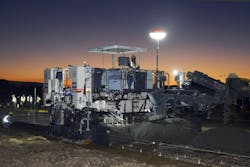Sunrise success: Contractor uses slipform paver to complete Texas residential project
A Texas concrete slipform paving contractor took advantage of the cool and uncongested early morning hours before sunup to start the day's work and end it before noontime.
That was the game plan for constructing miles of concrete pavement for a massive residential project—Southern Pointe Community—underway in late 2018 on the site of the former Texas World Speedway just south of College Station, and it is one to which the company adheres for most of its concrete paving projects.
There, Larry Young Paving Inc. of Bryan, Texas, began paving at 2 a.m. and knocked off about 11 a.m. Starting early resolves issues of faulty curing due to the excessive heat of the day and eliminates holdups of mixer trucks in crushing urban traffic.
Larry Young Paving has a big advantage, as it is the only contractor in town with a slipform paver, a two-track SP 62i from Wirtgen Group. In October 2018, this paver was put to work in the pre-dawn hours at the Southern Pointe residential development, placing a 2,200-ft-long pavement 19 ft in width, some 1,100 cu yd of concrete.
"We're placing half the 38-ft.-wide roadway, with a longitudinal joint in the middle using tie-bars," said Mark Schinzler, operations manager. "As soon as we finish we'll get off of that, and three days later get back on it and place the other side."
The slump of the concrete is 2 to 3 in., Schinzler said. "We need a low slump so it will stand up on the sides and curb," he said. "Consistency of the concrete is very important for the pour, obviously. It's a city mix with crushed river gravel which will reach 3,500 psi in 28 days, but historically it will be close to that in seven days."
Hydraulic vibrators are set at 16 in. spacing, and the frequency is 125 vibrations per second. Crown is 3% from centerline and is controlled off two string lines. The SP 62i can run slope control up to 16 ft if contractors want to run without a string on one side.
Texas DOT slipform paving typically is on a cement- or lime-stabilized base, with an asphalt pavement bond-breaker, topped with fresh concrete, Schinzler said, adding cities are doing lime stabilization, then concrete, with no asphalt seam. "This pavement is a jointed concrete pavement, not continuously reinforced, placed on a 6-in. lime-stabilized subgrade," he said. "We've done both continuous and hand-jointed work with the paver, from 7 in. to 11 in. in depth."
The SP 62i places concrete slabs from 6 ft 6 in. to 24 ft wide, and up to 18 in. deep, but also places curb with the right mold. The SP 60i platform of pavers is available in two tracks (SP 62i) and four tracks (SP 64i).
